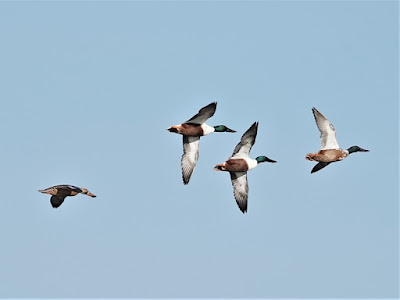A drake Teal passed by.
As does a drake Gadwall in need of a handkerchief.
A trio of Shoveler with two drakes pursing a duck.
Back they go being led by a younger drake still moulting in to adult plumage.
Now a duo of drake Shoveler. The left-most bird also still moulting.
A close-up of a duck Shoveler.
There were still many Lapwings flying around.
Here is a Lapwing formation team. The typically nervous Lapwings were being put to flight by several passing birds of prey.
One of the them was this female Sparrowhawk (males have a rufous barring)...
...coming around for a second pass.
This Red Kite had much the same effect on the Lapwings.
A welcome sighting was this Common Snipe, here with its bill open and a morsel being extracted.
Here are two Common Snipe.
And now three.
Here to prove they are properly regarded as part of the wader family.
Usually a few Cormorants around. Here is one leaving. Note the blue eye.
A visit to the woodland hide in sunny weather can produce some great images of birds checking the surroundings of the feeders. Here is one of a number of photos I took of the engaging Blue Tit.
Another. Note how the blue at the very front of the head almost glows.
Not often you can see this species has a blue-tinged tail.
One about to fall off its perch?
Last one. Again the blue on the front of the head is much brighter. Just how many shades of blue are there in the plumage.
A Great Tit waiting its turn.
There is always a friendly Robin.
A cooperative Dunnock in the sun.
Another seen in the shade.
Somewhat understated but a complex mix of colours are male Chaffinches.
Even more understated is this female Chaffinch.
A pensive-looking male Greenfinch.
The only chance I got to photograph this female Reed Bunting was at a feeder – and a rather distant feeder at that. Males are always blacker on the head and in breeding condition their head is jet black apart from the white moustachial stripe it shares with the female.
(Ed Wilson)





























